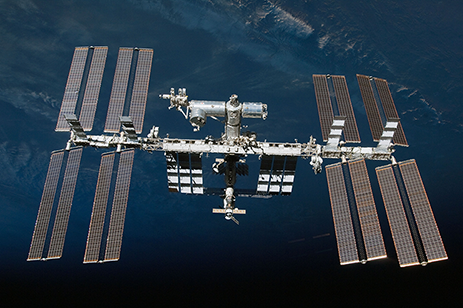
The Advanced Closed-Loop System (ACLS) is a regenerative life support system that is planned for installation in the Columbus module of the International Space Station (ISS). It converts waste carbon dioxide (from astronauts breathing) and hydrogen (from the electrolysis of water) into breathable oxygen using the Sabatier process and generates excess water for the crew onboard ISS (450kg of water per annum).
The ACLS will be an important element in the life support system on-board ISS and will also have the added benefit of reducing the costs involved in transporting water to the ISS (It costs anything up to $25K to launch one kilogram of mass into low earth orbit – this is a potential $11M+ saving per annum in transportation costs). ACLS is planned for launch in 2016 on a Japan Aerospace Exploration Agency (JAXA) HTV-II launch vehicle. The ACLS is to be accommodated in a double International Standard Payload Rack (ISPR) and is to contain all main and support functions like power, data handling, and process management.
The ACLS consists of the Oxygen Generation Assembly (OGA) and a Carbon Dioxide Concentration Assembly (CCA) – both of these sub-systems required a continuous data monitoring capability, specifically for temperature and pressure sensors installed on the assemblies. ACLS uses similar technology to the life support systems required on-board submarines.
The ACLS monitoring system required a number of distributed Data Acquisition Units (DAU) for both the OGA and CCA. The solution needed to be low-cost and as much as possible, based on existing equipment. Size and weight was also a factor given the limited accommodation for the data acquisition units within ACLS and the need to minimize the weight of the ACLS for transporting to the ISS.
It was a requirement that the system is able to operate for 10 years in the low earth orbit environment on the international space station and by extension, be able to function correctly in the presence of high-energy radiation in a low-earth orbit.
Curtiss-Wright had been in discussions with the ACLS manufacturer on the scope of this data acquisition requirement since 2010 and it became apparent that there was an off-the-shelf system available that had traditionally been used for flight testing. In response to this data monitoring system requirement, Curtiss-Wright was able to provide a space-qualified COTS Acra KAM-500 modular networked data acquisition assembly as part of the ACLS Avionics Subsystems Architecture that could monitor both the OGA and CCA concurrently, and provide this information to the ACLS’s onboard computer.
Curtiss-Wright delivered a turnkey customer solution involving Space COTS KAM-500 DAUs, product qualification, and program management ahead of program schedule and on budget.
The ACLS data monitoring subsystems are one of the first applications of COTS data acquisition equipment in a mission-critical space system. This successful use of Space COTS is part of a growing trend within the space industry to
- Re-use existing technology on launch vehicles, re-entry vehicles, and micro-gravity platforms
- Reduce development time and equipment cost for a particular mission
- As a result of ACLS, Curtiss-Wright has demonstrated the reliability of our Space COTS for a long duration, mission-critical applications
Download the case study to learn more.